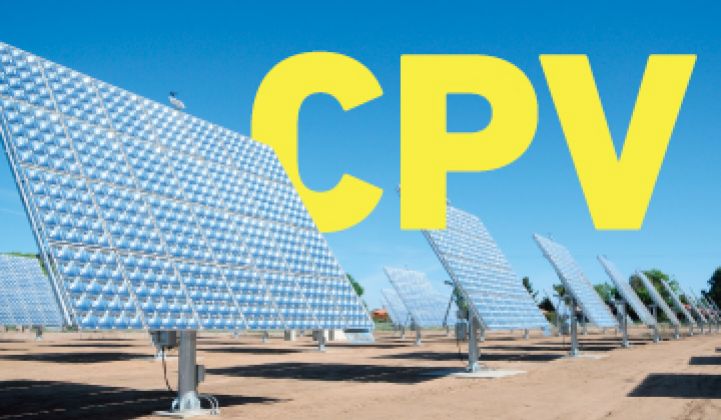The verdict is still out on whether concentrating photovoltaics (CPV) can really hold its own against flat-panel crystalline silicon (c-Si) PV.
While the c-Si market will deploy tens of gigawatts in 2012, CPV will commission tens of megawatts. As one of Greentech Media's readers said, "While the rest of the solar industry is immersed in hand-to-hand LCOE combat, the CPV world is still presenting bandgap analyses, Fresnel lens technology, and lattice matching."
On the other hand, CPV does have great potential in efficiency improvements -- improvements that could lead to considerably lower systems costs.
We've seen some positive action in CPV this week and in the last few weeks. Here's a quick re-cap:
Triple-junction solar cell manufacturer Solar Junction just announced that it has won a five-megawatt order from SolFocus for its very high efficiency solar cells.
Vijit Sabnis, VP of Technology and a co-founder of Solar Junction, asserts that no other photovoltaic technology has the headroom to improve its efficiency like triple-junction solar cells. He also asserts that because T-J cells are a smaller proportion of the system bill of materials (about 15 percent), no other cell technology's improvement can leverage down the cost of the system like CPV.
Solar Junction was founded in 2007 and is headquartered in San Jose, California with 44 employees. Its pilot production line is approximately 5 megawatts of 500X annual capacity on 4-inch wafers, and the firm has raised more than $50 million in equity from VC firms ATV, DFJ, NEA and strategic investor and epi-manufacturing partner IQE. Solar Junction currently holds the triple-junction cell efficiency world record of 43.5 percent.
So -- great technological progress at the CPV cell level is being made by Solar Junction (and Semprius, JDSU, Encore, and Spectrolab), but system vendors have to cut cost at the systems level in order to compete with the plummeting cost of single-axis c-Si.
How much is 5 megawatts of triple junction solar cells worth? The company didn't disclose that info, but we've heard estimates of about $0.40 per watt for the cells, which makes it a decent-sized $2 million order.
The 30-megawatt Alamosa Solar plant on 225 acres in Colorado is now the CPV heavyweight champion. It's the largest CPV project in the world and was officially put on the grid a few weeks ago. Cogentrix, the developer and recipient of a $90.6 million loan guarantee for the Alamosa project, just announced that it had "successfully begun commercial operation." The Alamosa plant will sell its electricity output to Public Service Company of Colorado, an Xcel Energy subsidiary. (Here's a Google Maps view of the site.) Cogentrix is a subsidiary of The Goldman Sachs Group and most of its previous projects have been for fossil fuel plants. Cogentrix used the concentrating panels from CPV veteran Amonix, the Kleiner Perkins- and Westly Group-backed solar hardware supplier. This project uses more than 500 60-kilowatt tracker assemblies, each 70 feet wide and 50 feet tall. Inverters for the facility are supplied by Solectria.
Greenvolts, a smaller player in CPV systems, "announced the commissioning of three solar projects for the City of Somerton, Arizona" to generate 416 kilowatts of electrical power for the city'’s water treatment, public safety, and water supply applications.
SolFocus won $10.75 million in venture capital from NEA, Apex, NGEN, et al. according to an SEC filing. SolFocus has a project in development in Mexico that could eclipse the Colorado CPV farm. Soitec has large CPV plants in the works as well including over 150 megawatts of PPAs with San Diego Gas & Electric and a 50 megawatt plant in South Africa.



